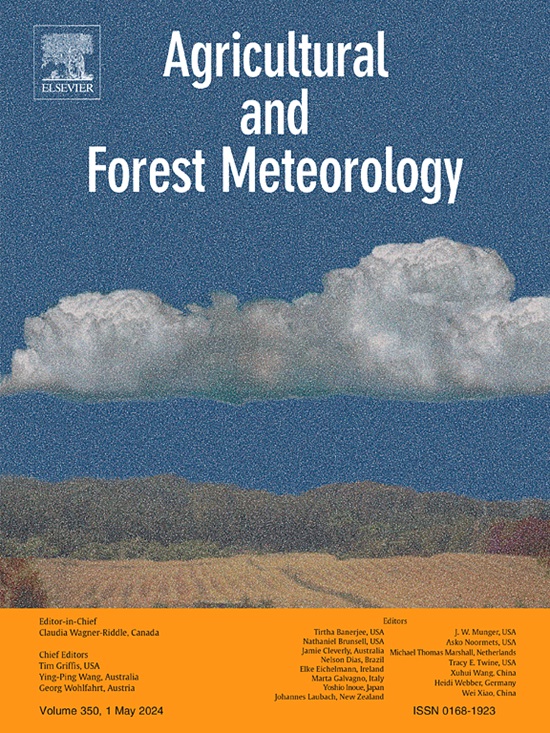Quantification and comparison of prediction uncertainty associated with different practices of crop modeling
IF 5.6
1区 农林科学
Q1 AGRONOMY
引用次数: 0
Abstract
Crop models are widely used as decision support tools in agriculture and natural resource management. However, the current practices in crop modeling and evaluation vary significantly, making it challenging to compare uncertainties across different models and studies. This study aims to quantify and compare the uncertainties associated with four different crop modeling practices using a standardized evaluation framework. The four modeling practices are: 1) using a single model, considering only model bias for uncertainty; 2) using a single model, accounting for both model bias and parameter uncertainty; 3) employing a multi-model ensemble to account for model bias, parameter uncertainty, and structural uncertainties; and 4) using a multi-model ensemble to consider uncertainties induced by model bias, parameters, structures, and inputs. We developed a framework that integrates Markov Chain Monte Carlo (MCMC) and Bayesian Model Averaging (BMA) to consistently quantify prediction uncertainty across these practices. The framework was applied to an Asian rice dataset. The results revealed that common model evaluation approach (Practice 1) tends to underestimate the uncertainty of model predictions. Relying on a single process-based model presents a substantial risk in critical decision-making situations. In contrast, the BMA ensemble predictor (e-BMA) demonstrated higher reliability, making it a preferable choice for future decision support. Our Bayesian framework provides a more robust and adaptable approach for project-specific decision-making, with promising applications in digital agriculture.
与不同作物模拟方法相关的预测不确定性的量化和比较
作物模型在农业和自然资源管理中被广泛用作决策支持工具。然而,目前作物建模和评估的实践差异很大,这使得比较不同模型和研究之间的不确定性具有挑战性。本研究旨在使用标准化评估框架量化和比较与四种不同作物建模实践相关的不确定性。四种建模实践是:1)使用单一模型,只考虑不确定性的模型偏差;2)使用单一模型,同时考虑模型偏差和参数不确定性;3)采用多模型集成来考虑模型偏差、参数不确定性和结构不确定性;4)使用多模型集成来考虑模型偏差、参数、结构和输入引起的不确定性。我们开发了一个框架,集成了马尔可夫链蒙特卡罗(MCMC)和贝叶斯模型平均(BMA),以一致地量化这些实践中的预测不确定性。该框架应用于亚洲水稻数据集。结果表明,常用的模型评估方法(实践1)往往低估了模型预测的不确定性。在关键的决策情况下,依赖单一的基于过程的模型会带来巨大的风险。相比之下,BMA集成预测器(e-BMA)显示出更高的可靠性,使其成为未来决策支持的首选。我们的贝叶斯框架为具体项目的决策提供了更强大、适应性更强的方法,在数字农业中有很好的应用前景。
本文章由计算机程序翻译,如有差异,请以英文原文为准。
求助全文
约1分钟内获得全文
求助全文
来源期刊
CiteScore
10.30
自引率
9.70%
发文量
415
审稿时长
69 days
期刊介绍:
Agricultural and Forest Meteorology is an international journal for the publication of original articles and reviews on the inter-relationship between meteorology, agriculture, forestry, and natural ecosystems. Emphasis is on basic and applied scientific research relevant to practical problems in the field of plant and soil sciences, ecology and biogeochemistry as affected by weather as well as climate variability and change. Theoretical models should be tested against experimental data. Articles must appeal to an international audience. Special issues devoted to single topics are also published.
Typical topics include canopy micrometeorology (e.g. canopy radiation transfer, turbulence near the ground, evapotranspiration, energy balance, fluxes of trace gases), micrometeorological instrumentation (e.g., sensors for trace gases, flux measurement instruments, radiation measurement techniques), aerobiology (e.g. the dispersion of pollen, spores, insects and pesticides), biometeorology (e.g. the effect of weather and climate on plant distribution, crop yield, water-use efficiency, and plant phenology), forest-fire/weather interactions, and feedbacks from vegetation to weather and the climate system.

 求助内容:
求助内容: 应助结果提醒方式:
应助结果提醒方式:


